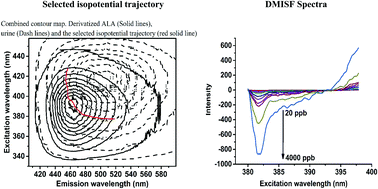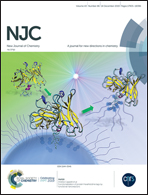Derivative matrix-isopotential synchronous spectrofluorimetry: a solution for the direct determination of urinary δ-aminolevulinic acid†
Abstract
δ-Aminolevulinic acid (δ-ALA) plays a vital role in the diagnosis and clinical screening of diseases like lead poisoning, hepatic porphyria, and hereditary tyrosinemia type-1. However, because of the drawbacks of the existing methods, such as tedious pre-separations and analytical interference, it poses a serious challenge for an efficient, specific, and simple δ-ALA detection strategy. In this work, matrix-isopotential synchronous fluorescence spectrometry (MISFS) and the first derivative technique are combined for the direct determination of δ-ALA in urine samples. The proposed approach promises the detection of δ-ALA in urine samples with unknown background fluorescence, alleviating complicated and tedious pre-separation processes. Here, the fluorescent derivatization of δ-ALA was based on the Hantzsch reaction. MISF spectra were scanned along a matrix-isopotential trajectory, which combines the points of equal intensity in theoretical 3D contours. The contours were constructed from the excitation and emission spectra of δ-ALA and urine. The unknown background signal of the urine was suppressed by the first order derivative technique. Maximum sensitivity and appropriate selectivity were ensured by the study of the experimental variables in the δ-ALA bands, centered at its excitation and emission maxima (392.6 nm and 464.5 nm). The limits of detection and quantification, calculated according to IUPAC definitions, were 5.4 ppb and 18 ppb, respectively. The average recoveries were 97.2% ± 2.6%. For within-run precisions, the inter-day and intra-day CVs were 5.3% and 3.6%, respectively. The results achieved by the proposed method were consistent with those obtained by the conventional HPLC-FLD method.



 Please wait while we load your content...
Please wait while we load your content...